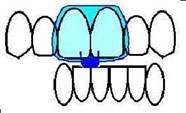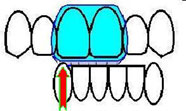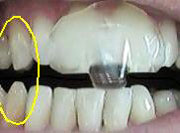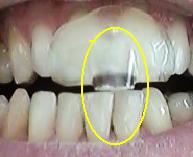 CELEBRATING **25** YEARS OF DENTAL EXCELLENCE | | ISO 9001:2000 CERTIFIED |
A2 AASHIRWAD, II CROSS LANE, LOKHANDWALA COMPLEX, ANDHERI (WEST), MUMBAI 400053, INDIA | 2632 8682 / 3082 7053 / 98193 63215 |
 CELEBRATING **25** YEARS OF DENTAL EXCELLENCE | | ISO 9001:2000 CERTIFIED |
A2 AASHIRWAD, II CROSS LANE, LOKHANDWALA COMPLEX, ANDHERI (WEST), MUMBAI 400053, INDIA | 2632 8682 / 3082 7053 / 98193 63215 |
| Antibiotics | Baby Teeth | Bad Breath | Bleaching | Bonding | Brushing | Bruxism | Caries (Decay) | Cosmetic Dentistry | Crowns & Bridges | Dentures | Dry Mouth | Emergencies | Endodontics | Extraction | Flossing | Gum Disease | Implants | Migraine | NTI | Oral Cancer | Orthodontia | Pregnancy | Preventive | Sealants | Silver fillings | Tobacco | Toothpastes | Veneers | Wisdom Teeth | XRays |
|
THE NTI-TSS SYSTEM |
What is NTI-tss? |
|
The N.T.I. Tension Suppression System is a prefabricated poly carbonate matrix that a dentist fits to you. It is completely different from any other type of mouthpiece.The NTI is a small, nearly invisible plastic device that you wear over your front teeth while you sleep. In one short visit we can custom make the NTI oral appliance for you.Wearing the NTI reduces clenching intensity by 66%. In a few days or weeks, morning headache pain, neck pain, sore jaws, and other related pain associated with involuntary intense clenching usually begin to disappear.  |
| The delivery sequence of an NTI-tss. (The big white things in the lower corners of the middle photos are a dentist's gloved fingers!)
|
|
How does it help? By reducing clenching intensity and preventing grinding the NTI relieves or resolves:
Has this treatment been tested? The NTI device has been used successfully with thousands of patients. In 1998, it received FDA approvalfor preventing clenching, grinding, and tension-type headaches. In June of 2001, the NTI gained approval for preventing migraines. Can an NTI really help me feel better? A. Many people with tension-type headaches report significant relief overnight B. Clinical trials of migraine sufferers show that: 82% of
NTI users had a 77% average reduction in migraine events
Imitrex
use was reduced by almost 50%
Nausea
episodes were reduced by 78%
Light-sensitive episodes were reduced by 66%
Sound-sensitive episodes were reduced by 68%
There
were no side effects or pain |
How Does It Work? |
Chronic symptoms of the head and neck can often be attributed to:
Contraction of the lateral pterygoid (A, above) simply moves the jaw sideways (or if both contract, front wards).If the temporalis (B, above) contracts simultaneously (clenching), the intensity of the temporalis contraction dictates the degree of resistance the lateral pterygoids encounter when they attempt to move the jaw sideways.As temporalis contraction intensity increases, the lateral pterygoids must work harder, creating symptoms where the muscle is attached (the TM joint and sinuses), and obligating the trapezius to maintain a tightened posture (stiff and sore neck). When there is temporalis contraction exclusively (no lateral activity), the jaw joint and sinuses are less strained,while resultant
temporalis pain may be considerable. Tension-type headache patients without jaw disorders clench their jaws 14 times more intensely while sleeping than do asymptomatic controls.
A traditional dental mouthpiece, or splint, reduces the resistance to side-to-side movement, thereby reducing the effort and resultant strain to the jaw joint and sinuses . The same splint also provides an ideal clenching surface. The
temporalis can be felt contracting (it will bulge slightly) when clenching with or without a splint.
An object placed in the mouth on the front
teeth (as a pencil), reduces the temporalis' contraction intensity by at least 66%. An "Anterior Midline Point Stop" (AMPS) with specific modifications can prevent the temporalis contaction intensity, thereby treating and preventing: chronic headache, TMJ problems, sinuses signs and symptoms, and stiff and sore neck.
|
|
Application and General Protocol for the NTI-tss |
|
Diagnosis and Indications: The NTI-tss is indicated in those diagnosed conditions whose treatment (or prevention of) warrants/requires any combination of: |
|
Examples of indicated uses: |
|
Method of Action: Prevention of above conditions is accomplished by preventing the occlud-ING of the canine and posterior teeth during parafunctional events. There is only one way in which an individual can generate adverse joint strain (which perpetuates an internal derangement), or maintain a less-than-optimal condylar orientation, or to perpetuate muscular dysfunction, and that is to achieve certain degrees of muscular tension. This tension is made possible by the occluding of the canine or posterior teeth. Certainly, if one were to maintain "rest position" (lips together, teeth apart), there would be none of the conditions cited above. |
| Application: The NTI-tss (a) is a simple modification of the tradition anterior deprogrammer (b), thereby preventing canine and posterior contacting in parafunctional movements. |
a) b) b) |
| In addition to preventing canine occluding in excursive movement, posterior occluding must be prevented as well (c). In some instances, it may be necessary to reduce a palatal or distal-buccal cusp to comply (d). | c) d) d) |
| Minimal vertical opening: Excessive vertical opening will allow for strain on a TMJ in excursive movement (e), and may encourage a clenching response. Vertical opening must be kept to a minimum, without allowing for canine or posterior occluding (f). |
(e) f) f)
 |
| Conclusions: Without adverse effects, the NTI-tss: --Prevents bruxism and chronic pericranial muscular tension; --Prevents destructive joint strain; --Prevents or reduces frequent migraine pain and related chronic tension-type headache. *Thereby allowing the dentist to procede with comprehensive care and occlusal therapy where indicated. | |
|
Our thanks to James P. Boyd, DDS
for developing the NTI |
|
RELATED TOPICS |
| Antibiotics | Baby Teeth | Bad Breath | Bleaching | Bonding | Brushing | Bruxism | Caries (Decay) | Cosmetic Dentistry | Crowns & Bridges | Dentures | Dry Mouth | Emergencies | Endodontics | Extraction | Flossing | Gum Disease | Implants | Migraine | NTI | Oral Cancer | Orthodontia | Pregnancy | Preventive | Sealants | Silver fillings | Tobacco | Toothpastes | Veneers | Wisdom Teeth | XRays | Dental Tourism |